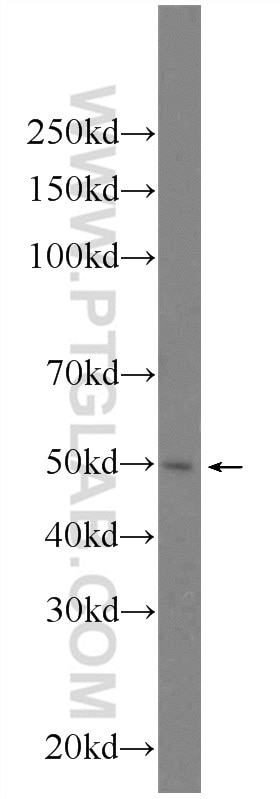Tested Applications
| Positive WB detected in | HeLa cells |
Recommended dilution
| Application | Dilution |
|---|---|
| Western Blot (WB) | WB : 1:200-1:1000 |
| It is recommended that this reagent should be titrated in each testing system to obtain optimal results. | |
| Sample-dependent, Check data in validation data gallery. | |
Product Information
24560-1-AP targets FYTTD1 in WB, ELISA applications and shows reactivity with human samples.
| Tested Reactivity | human |
| Host / Isotype | Rabbit / IgG |
| Class | Polyclonal |
| Type | Antibody |
| Immunogen | FYTTD1 fusion protein Ag20051 Predict reactive species |
| Full Name | forty-two-three domain containing 1 |
| Calculated Molecular Weight | 318 aa, 36 kDa |
| Observed Molecular Weight | 50 kDa |
| GenBank Accession Number | BC039734 |
| Gene Symbol | FYTTD1 |
| Gene ID (NCBI) | 84248 |
| RRID | AB_2879609 |
| Conjugate | Unconjugated |
| Form | Liquid |
| Purification Method | Antigen affinity purification |
| UNIPROT ID | Q96QD9 |
| Storage Buffer | PBS with 0.02% sodium azide and 50% glycerol , pH 7.3 |
| Storage Conditions | Store at -20°C. Stable for one year after shipment. Aliquoting is unnecessary for -20oC storage. 20ul sizes contain 0.1% BSA. |
Background Information
FYTTD1 also termed as UAP56 interacting factor or UIF is a 318 amino acid protein, which belongs to the UIF family. FYTTD1 localizes to nucleus and is required for mRNA export from nucleus to cytoplasm. Functioning as an adaptor, FYTTD1 utilizes the BAT1/DDX39-TAP pathway, which is essential for efficient mRNA export and nuclear pore delivery. FYTTD1 interacts with SSRP1, a protein that is necessary for its recruitment of mRNAs, in addition to a mutually exclusive interaction with BAT1/DDX39 and TAP. The molecular weight of post-translation modified FYTTD1 is observed 50 kDa.
Protocols
| Product Specific Protocols | |
|---|---|
| WB protocol for FYTTD1 antibody 24560-1-AP | Download protocol |
| Standard Protocols | |
|---|---|
| Click here to view our Standard Protocols |



